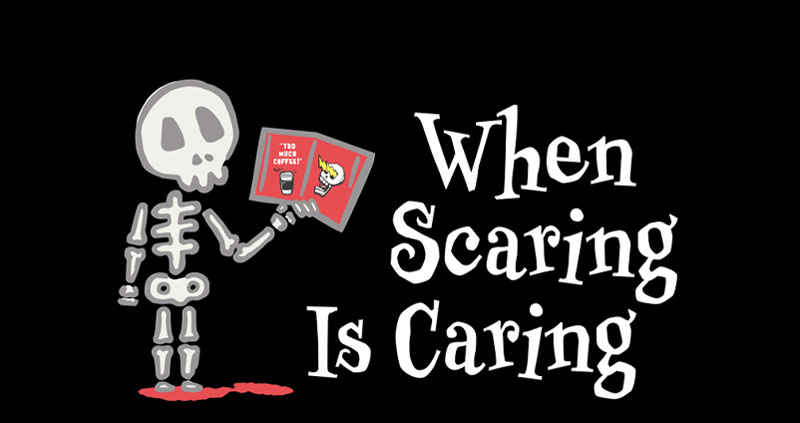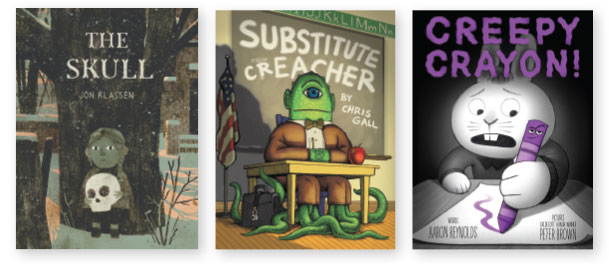Spooky Picture Book Recommendations From a Confessed Fraidy-Cat
Travis Jonker shares key elements of a good scary book for young students, titles he loves, and tips for successful spooky read-alouds (video included).
 |
SLJ montage using Getty Images: katoten (skeleton); demianvs (skull); and Ilya Oktyabr (cup). |
I have a confession to make: I’m an easy scare. In elementary school, I watched The Fly (the 1986 version starring Jeff Goldblum) with my cousins and was so traumatized that I had to sleep in my older brother’s room for two weeks. In high school, I bought the PlayStation horror video game Silent Hill and could only play it in the bright light of the afternoon, or else I would get too spooked. As a grown-up, I finally started watching the Netflix series Stranger Things with my daughter but bailed partway into the second season because (*mild spoiler alert*) Will became possessed and it freaked me out. Yep, I’ll be reading the Wikipedia episode summaries from here on out.
As a bona fide fraidy-cat, am I the least qualified person on Earth to write an article on scary books for kids? No. I humbly assert that I am very qualified. Why? I understand their power. I have a healthy fear of fear. And I’ve been sharing creepy books with students in my K–third grade school library for years. I’ve seen firsthand what works and what doesn’t. Surveying my favorite creepy picture books, I’ve noticed some commonalities. I’ll share those elements of a good spooky book along with titles I use.
First off, can we all agree that folktales can be terrifying? Many traditional stories have been watered down over the years, so it’s easy to forget that most began as cautionary tales. Snow White? Scary. Little Red Riding Hood? Scarier. Hansel and Gretel? Terrifying!

General rule of thumb: The closer a folktale is to the original version, the scarier. There are versions of these stories that either ratchet up the fear (Ed Young’s Lon Po Po, anyone?) or lessen it (Red Riding Hood retold by James Marshall). So you have options for how much creepiness you want your story time to have. Recent release The Skull by Jon Klassen is a Tyrolean folktale about a child who runs away and finds herself in a haunted castle—another example of a traditional tale with plenty of ominous elements.
It’s said when you are truly terrified, the color drains from your face. Similarly, when a picture book is creepy, the color is often drained from the illustrations. The art sets the mood. In Aaron Reynolds’s Creepy Carrots! (and follow-ups Creepy Pair of Underwear! and Creepy Crayon! ), illustrator Peter Brown used the old sci-fi/horror TV show The Twilight Zone for inspiration, making black-and-white artwork with a lone bright color (orange) to tell the story. In fact, many great creepy picture books use black and white (or a muted palette) to immerse readers in a world where things go bump in the night. Darkness adds fear. Anything can hide, waiting to jump out.
You know what else makes for a good creepy picture book? A good villain. What is our hero up against? A ghost? A monster? In Substitute Creatcher by Chris Gall, the guest teacher is an intimidating, tentacled beast, taking a naughty class to task. But as the story unfolds, a more sympathetic story is revealed. In the end, readers learn that the villain is actually the hero.
Weirdness also always helps. There are plenty of familiar elements in creepy stories, so when a book incorporates something from left field, it grabs readers. No one expects the dead dog to come back as a ghost in Bone Dog by Eric Rohmann. That makes the book unforgettable. While not technically a picture book, the famously grotesque early reader story “ The Green Ribbon” (adapted by Alvin Schwartz for his collection In a Dark, Dark Room) also taps into this element of weirdness. A girl curiously wears a green ribbon around her neck. The reveal that the ribbon is the only thing keeping her head on is a moment kids will never forget. Philip and Erin Stead’s Lenny & Lucy also plays into this, as the children build massive “golems” to protect them from whatever lies in wait across the first bridge (bonus points for the liberal use of black and white, adding an ominous touch). How to Make Friends with a Ghost by Rebecca Green also brings the unusual. It starts with tips for befriending a specter before dropping the hammer with the final revelation—that the reader will also one day pass away and become a ghost. No one would confuse Flavia Z. Drago’s Gustavo, the Shy Ghost for a truly scary book, but it flips the traditional ghost story on its head, introducing an apparition who must conquer his timidity to find a friend.

Suspense is perhaps the key element in a creepy picture book. Jan Thomas isn’t known for spooky books, but in The Doghouse, she expertly builds the suspense, encouraging readers to wonder what lies in the shadows—before a surprise twist relieves the tension with a dose of humor. The classic The Monster at the End of This Book by Jon Stone might be the first “scary” story many kids read. It combines humor with interactive tension, as every turn of the page brings Grover (and the reader) closer to the feared monster. The gently spooky The Little Old Lady Who Was Not Afraid of Anything by Linda Williams also makes good use of suspense, as the protagonist is pursued by a series of disembodied clothing items making noises in the dark. Suspense builds until the final page when the creepy clothing assembles into a scarecrow for the little old lady’s garden. The recent Great Zombie Pumpkin Parade! by Robert Burleigh is another good example of a suspenseful read. A group of jack-o’-lanterns make their yearly trek into town for the creepiest night of the year. Yes, the artwork is spooky, but it’s the suspense of “Where are these zombie pumpkins going???” that keeps readers engaged.
Spooky descriptions can be a powerful element of scary picture books. One of the best creepy read-alouds is Monster Trucks by Anika Denise. Each truck is modeled after a famous monster, with dripping fangs and ominous wails. Denise takes the idea of a race and makes the ultimate example of outrunning your fears. The truly gross zombie foods in Zombies Don’t Eat Veggies! by Jorge Lacera is a primary charm of that book, a student favorite. R. L. Stine’s Little Shop of Monsters does such a good job bringing disgusting monsters to life that it doesn’t even need a plot: young readers are transfixed by the ghoulish parade.
Humor can also be a key element to a good creepy picture book—it can break the tension and let readers laugh at their own fears. A Spoonful of Frogs by Casey Lyall is a funny story set in the world of creepiness, as a witch tries to catch a frog so that she can complete her brew. Hardly Haunted by Jessie Sima does a nice job of this, too, personifying a slightly spooky house that just wants to be a regular home. Bob Shea’s The Scariest Book Ever also allows readers to laugh at their fears. So although I don’t have much tolerance for creepiness, I can appreciate it. And as a librarian, I know for a fact that scary books are some of the most read in our library. As long as no one makes a picture-book adaptation of The Fly, I’ll be OK.
Spooky read-aloud tipsRead the room. Think about your audience and what they can handle. As much as I might want to pull out some Alvin Schwartz and turn the scary up to 11, it may not play well with kindergartners. Don’t be afraid to get quiet. Also, loud. Volume modulation is important for every read aloud, but never more than with a creepy book. Set the mood by dropping down to a near whisper during moments of suspense. This will make the loud moments of surprise all the more potent. Blow your sound and lighting budget. Oh, you don’t have a budget for spooky sound and lighting? Me neither. But you can always turn off the lights and pull out a flashlight or play a spooky soundtrack on YouTube or Spotify as you read. |
Travis Jonker blogs at “100 Scope Notes.”
RELATED
The job outlook in 2030: Librarians will be in demand
The job outlook in 2030: Librarians will be in demand
ALREADY A SUBSCRIBER? LOG IN
We are currently offering this content for free. Sign up now to activate your personal profile, where you can save articles for future viewing






Add Comment :-
Be the first reader to comment.
Comment Policy:
Comment should not be empty !!!